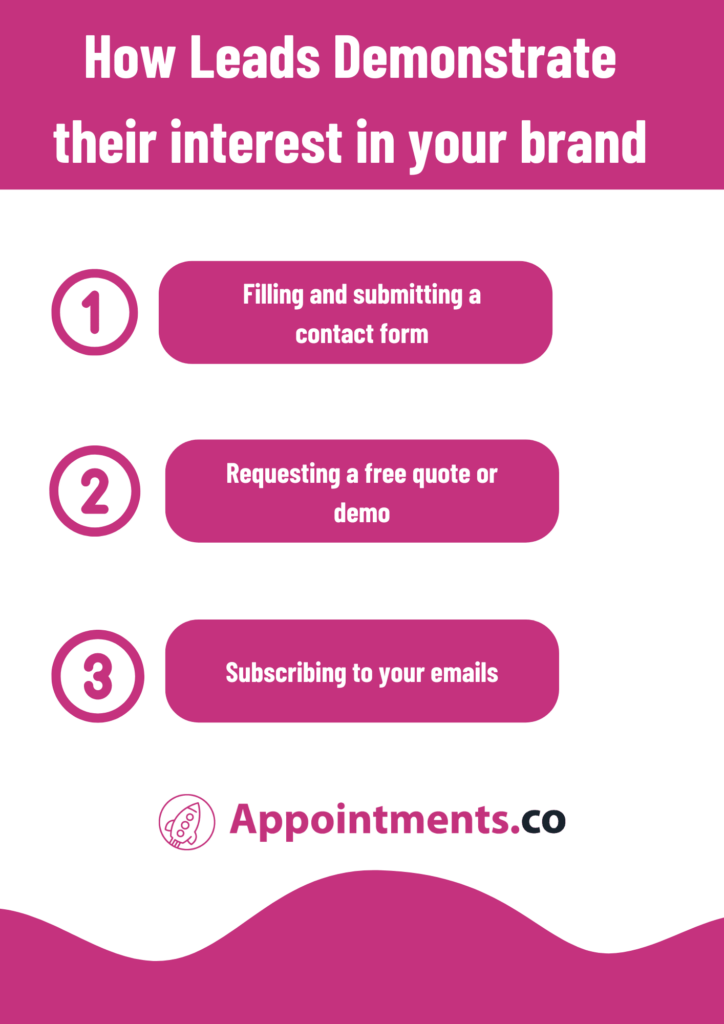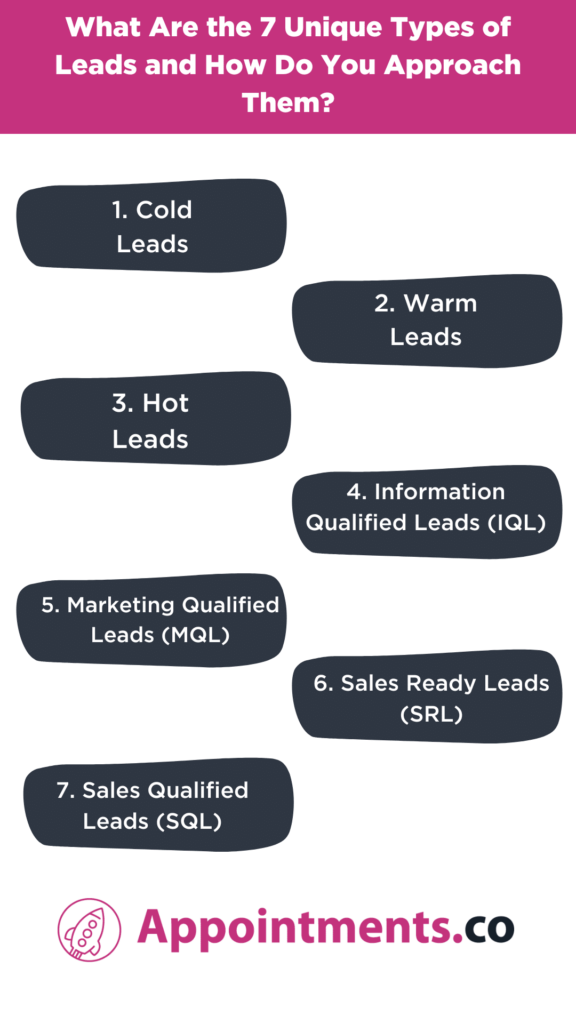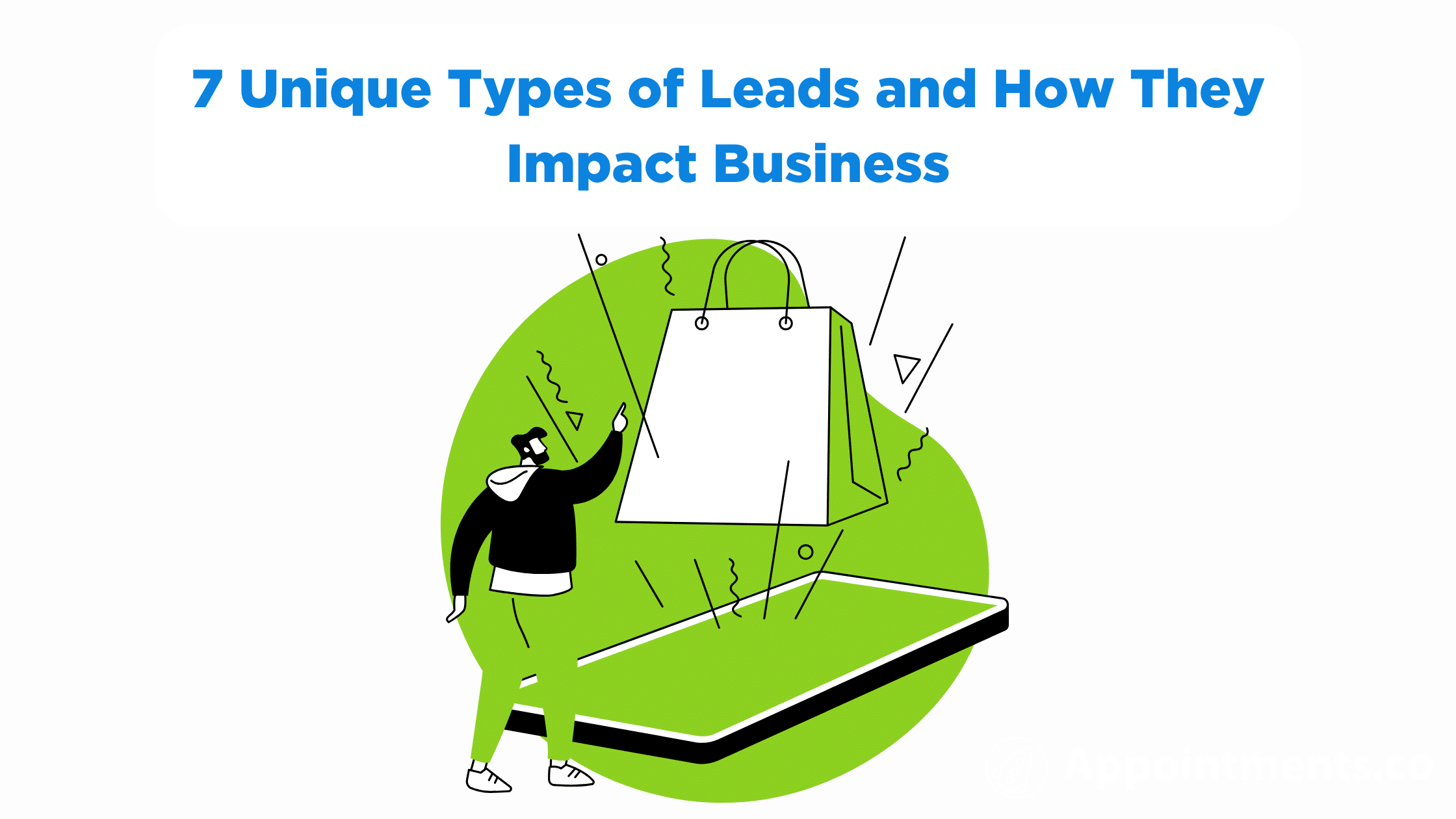To increase revenue and achieve business growth, it’s crucial to generate and convert high-quality leads. But, how can you effectively generate leads that actually become customers and clients?
The key lies in understanding the various types of sales leads and mastering the art of conversion. By familiarizing yourself with the different lead types in sales, you can gain insight into how to successfully turn prospects into revenue.
If you’re eager to learn more about these lead types and discover effective strategies for converting them, keep reading!
Table of Contents:
- What Are Sales Leads?
- How Do Sales Leads Impact Your Business
- What Are the 7 Unique Types of Leads and How Do You Approach Them?
- Frequently Asked Questions
- Conclusion
What Are Sales Leads?
Sales leads, also known as business leads, are individuals who align with your ideal customer profile or have shown an interest in your business, products, or services. Essentially, they are potential customers or clients.
Leads can demonstrate their interest in your brand through various actions, such as:

- Completing your contact form
- Requesting a free quote or demo
- Subscribing to your emails
Different types of leads can be generated based on the interactions and expressions of interest from your leads.
To enhance conversions and sales, it is vital to nurture these leads effectively by providing them with the right information at the right time. This approach ensures that they receive the necessary guidance and support throughout their journey, increasing the likelihood of successful conversions and sales.
How Do Sales Leads Impact Your Business
To be honest, not all your sales leads become paying customers, but without those leads, a business cannot run, as there are no sales either. Keep in mind that every customer starts as a business lead.
On top of that, there are also other advantages that come with lead generation. Every potential paying customer that comes into your business as a lead could also possibly be a referral. In other words, every business lead has the potential to become your paying customer and also your referral that guides even more leads into your sales funnel. This indicates that if you generate business leads, you acquire new customers and drive more sales.
Regardless of the business, sales lead to propel the growth, scalability, sustainability, and profitability of your business. There are also different types of leads that have an impact on your business in various aspects.
What Are the 7 Unique Types of Leads and How Do You Approach Them?

These are the 7 different types of leads in business that you should be aware of to understand how each type works and what their needs and pain points are. This not only helps you generate more types of leads but also helps you to nurture them and see how you can convert them from your potential sales leads to your paying customers.
After generating leads you must classify them into types of leads, so you can easily identify their needs and nurture them accordingly.
1. Cold Leads
Cold leads are leads that refer to individuals who fit your customer profile but have not yet engaged with your company. Converting these types of leads can be challenging because they do not have an active interest in your business.
The term “cold leads” is reminiscent of the concept of “cold-calling,” where you attempt to convert individuals who have had no prior interaction with your business. Converting such types of leads is a difficult task, and it is important to be prepared for the possibility that many of them may not convert.
Nevertheless, there are strategies to convert cold leads. One effective approach is to nurture them through the marketing funnel by providing top-of-funnel content, such as blog posts and social media content. Additionally, you can try reaching out to them through cold-calling or email outreach.
How to reach out to cold leads:
- Be persistent: Use a combination of calls, emails, and social interactions in as few words to stay in touch. Request a follow-up on your emails and reiterate the purpose of setting up a meeting during calls. Persistence increases the chances of landing a meeting.
- Lead with pain points: Research the cold lead’s business and position yourself as a problem solver. Show that you understand the challenges faced by their business in their domain and how your solutions can help them.
- Nurture them: If you don’t receive a response initially, don’t worry. Add these types of leads to a nurture campaign and send them helpful information, such as blog posts and industry articles via email. This keeps you on their radar until they are ready to engage with you again.
Remember, consistent effort, understanding their pain points, and nurturing them over time are key elements in converting cold leads into customers or clients.
2. Warm Leads
Warm leads are familiar with your brand and offers but haven’t shown a strong interest in buying yet. They may visit your website, follow you on social media, or subscribe to your emails. To market to them effectively, use CTAs in your content and reach out directly with personalized emails or phone calls to discuss your products/services. Many warm leads are interested in hearing more.
How to reach out to warm leads:
- Appointments: Set up a time to have just a casual conversation with your clients to learn about their needs and business type.
- Check Again – If you have reached out to your interested prospects, but they didn’t buy your product or service due to an insufficient budget, or just bad timing, you can check in with them again later, and keep them updated.
3. Hot Leads
Hot leads are those who exhibit clear and enthusiastic interest in your products or services. While they haven’t made a purchase commitment yet, they have shown strong indications that they are actively considering it. These leads might be engaged in discussions with your team or taking advantage of any free trial offers you provide.
When it comes to hot leads, your marketing efforts can be more direct and assertive. You have the opportunity to openly encourage them to make a purchase by emphasizing the numerous benefits of your offers and highlighting the unique qualities that set your business apart from competitors. This is the stage where you can confidently push for conversion and make a compelling case for why they should choose your product or service.
Things to keep in mind when reaching out to hot leads:
- Need: Hot leads have expressed a pain point that your business can address for them. Tailor your outreach to highlight how your product or service can specifically meet their needs.
- Authority: Hot leads are typically decision-makers, or have purchasing power within their company. Ensure that your communication is directed toward the person who can make the final buying decision.
- Company fit: Hot leads come from businesses that align with your target market. Understand their industry, size, and specific requirements to demonstrate how your solution is relevant and beneficial to their particular business.
To convert a hot lead into a prospect, conduct thorough research on their business to ensure that you can genuinely support their needs. Then, set up a follow-up meeting to initiate the discovery phase of the sales process and better understand their specific requirements and pain points.
We have discussed three types of leads so far. Now, let’s move on to information qualified leads.
4. Information Qualified Leads (IQL)
An information qualified lead (IQL) refers to a lead who is in the early stages of exploring potential solutions for their problem. These types of leads typically provide some details about their business when they fill out a form to access valuable resources, such as free ebooks, webinars, or reports that you offer.
Although these types of leads haven’t expressed direct interest in your solutions yet, gathering information about their company, title, and type through these forms can help you qualify and assess their potential as a lead.
How to reach out to Information qualified leads:
- Discover their specific interests in learning more about your company and the solutions you provide.
- Maintain regular communication through emails, newsletters, and valuable content.
- Initiate contact by addressing their pain points with researched solutions, aiming to ignite their interest in your offers.
5. Marketing Qualified Leads (MQL)
MQLs are like warm leads further down the sales funnel. They are familiar with your brand and engage with your content, such as blogs. You may already have their email address from previous signups or downloads.
You can market to MQLs by integrating marketing messages into your informative content. Also, blend valuable information with sales-oriented content. Encourage the marketing qualified leads to join your email lists or try product demos to deepen their familiarity with your company.
You can identify a lead as a marketing qualified lead if they:
- Download case studies from your website.
- Watch videos about how your products or solutions work.
- Voluntarily sign up and attend webinars offered by your company.
As they actively seek more information about your solutions, converting them into prospects should be relatively straightforward. You can complete the qualification process through email or a conversation, and if appropriate, arrange a demo or presentation. It’s important to note that not all of them will choose your solution, so maintaining persistence and following up with emails is crucial.
6. Sales Ready Leads (SRL)
Sales-ready or accepted leads are toward the bottom of the sales funnel, and are considered ready to be handed over to the sales team for further processes. The readiness of these leads depends on the policies of your business.
One organization may consider the lead to be sales-ready even if they just download a case study, yet another organization may consider if the lead has shown enough interest.
To understand if a lead is sales-ready, you should take into consideration the following questions:
- Budget – Is your prospect willing to spend money?
- Authority – Does your prospect have the final say in the purchase?
- Need – Does the potential lead have a problem that needs your product or service as a solution?
- Timing – How urgently does your potential lead need a solution to their problem?
7. Sales Qualified Leads (SQL)
A sales qualified lead (SQL) is also one of the types of leads that are at the stage where they are prepared to engage with your sales team. They have shown significant interest in your offer and are ready to make a purchase. However, it’s possible that they are also evaluating your solution alongside your competitors. SQLs are highly valuable and require prompt attention.
Once you reach out to them, it’s important to verify their identity and then guide them through the sales process, as they are already fully qualified. You should also know to consider these questions before assuming they are sales qualified leads.
While being sales-ready is a positive indication, it doesn’t necessarily mean they are ready to make an immediate purchase. It’s crucial to continue nurturing these leads by following up with calls and providing demonstrations of your solutions to ensure they become fully prepared and ready to move forward with the buying process.
Frequently Asked Questions
1. How are leads important in business?
Having a reliable lead generation process enhances the credibility of your marketing efforts. It not only demonstrates tangible results but also showcases a return on investment (ROI).
2. What effect does lead generation have on a business?
Businesses can enhance their marketing and sales endeavors, boost conversion rates, and drive up sales and revenue by leveraging lead generation strategies. It is a valuable approach to optimizing business performance and achieving growth.
3. How do you convert leads to business?
1. Target the right market.
2. Organize and categorize leads.
3. Utilize lead scoring to prioritize leads.
4. Initiate immediate communication with converted leads.
5. Use effective communication channels.
6. Consistently follow up with leads.
7. Optimize sales team efficiency.
To Transform Types of Leads Into Loyal Customers,
It is crucial for your sales teams to understand each types of leads to provide them with proper nourishment throughout their sales journey. Keeping track of the sales lead’s progress status and calculating your lead conversion ratio helps you identify areas where improvements can be made to enhance the conversion process.
It is important to be patient, continuously refine your lead generation strategy, focus on your sales pitch, and make the necessary adjustments to achieve positive outcomes for your business. To generate and nurture potential leads and convert them into loyal customers you can take your business to the next level, don’t hesitate to appointment.co to learn more about our services.
Related Reads
- How To Increase Leads – 5 Winning Tips and Tricks
- Master the Art of Handling Appointment Setting Leads in 2023
- How to Nurture B2B Leads for Winning Deals – 10 Expert Tips
Illustration – Storyset



